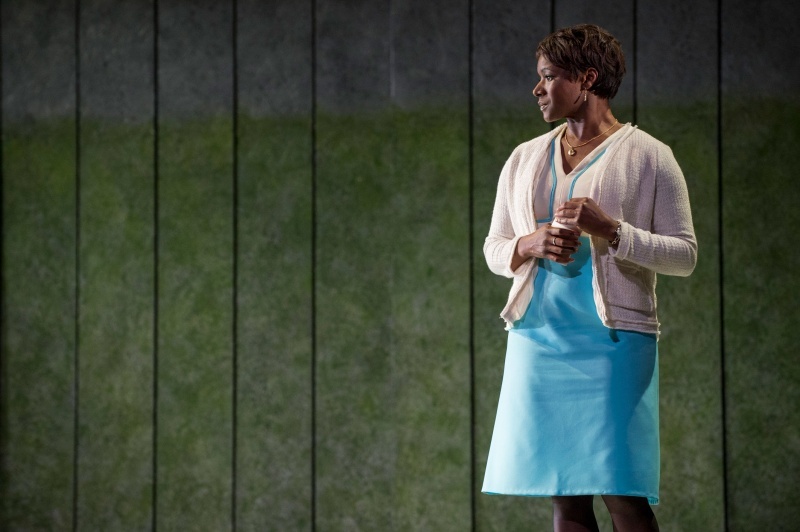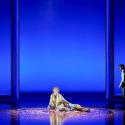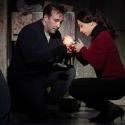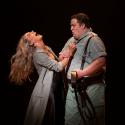Simon Boccanegra has, as English Touring Opera’s director James Conway points out, never quite made the running outside Italy amid Verdi’s output. It went through three to five different versions in a short space of time. Despite the Romeo and Juliet era setting (14th-century Genoa battling it out with Venice) there are naivetes in Piave and Boito’s plot which, despite the frenetic story’s many merits, generate more than the usual operatic implausibilities. These render some of the quickly changing political frummeries all but comic, so that Otello and Falstaff tend to make better running amid post-Don Carlo Verdi.
Conway has had a go at sharpening the opera’s dramatic and political intensity by relocating the action of Boccanegra to modern times (just as his Donizetti The Siege of Calais seeks affinities with wartime Stalingrad). This has merits, though Boccanegra’s dottier misunderstandings or non-recognitions seem even less plausible – even ludicrous - in an age of quick communications.
There is something Lear-like about Boccanegra’s dilemmas, and his failures
The era chosen is one of appalling Italian political violence – the period of Andreotti, Togliatti and the assassinated Aldo Moro; tensions between communist-socialist left and nearly neo-Fascist right; and the ruthless two-way slaughter by the Red Brigades and their rivals (Bologna station bombing, Moro’s maimed body found in a car boot).
As an evocation of that era, from the Jonathan Miller Rigoletto-like, Mafioso-style plottings of the opening scene, it does rather well. A major asset – some might disagree violently – is the immovable pillared set, with shades of Mussolini-type architecture, by the immensely gifted Faroese born set and costume designer Samal Blak, a Linbury-prize winner with a background in sculpture (it shows) and from Central St Martins.
Once Craig Smith’s Boccanegra, after a curiously unprepossessing prologue, becomes leader, he spends a lot of time stuck on a central placed curule chair, in which he finally expires, poisoned. The effect is static, almost monolithic. And I found it wholly apt, magisterial, impressive. There is something Lear-like about Boccanegra’s dilemmas, and his failures, and the grizzled Smith (unconvincingly young at the immediate postwar outset) has an isolated look - political, familial, emotional - which Conway strives to underline.
 The fact that Smith has (unknowingly) lost, before the action starts, his wife or lover, daughter of his enemy (the always robust but now vocally magnificent Keel Watson) and then almost carelessly mislaid his baby daughter (the glorious Elizabeth Llewellyn, in a ghastly, ill-designed turquoise skirt that never changes and annoys at every turn - pictured above right), only underlines his comparable failure, or rocky efforts, to hold the creaking state, and its shifting allegiances, together.
The fact that Smith has (unknowingly) lost, before the action starts, his wife or lover, daughter of his enemy (the always robust but now vocally magnificent Keel Watson) and then almost carelessly mislaid his baby daughter (the glorious Elizabeth Llewellyn, in a ghastly, ill-designed turquoise skirt that never changes and annoys at every turn - pictured above right), only underlines his comparable failure, or rocky efforts, to hold the creaking state, and its shifting allegiances, together.
The librettists spare us Shakespearian onstage battles – no Macbeth and Macduff: revolution breaks out and then simply concludes - so we never see Boccanegra with teeth bared, sword (or Kalashnikov) in hand. Smith remains a stern, angry but strangely placid leader, accepting his end (it’s a long death) a bit like Derek Jacobi’s Claudius swallowing the poisoned mushroom.
So this is a Boccanegra you will love or ridicule. A plonky prologue is redeemed by the magnificently cast Polish bass Piotr Lempa in a small(ish) role and the Australian-born Grant Doyle. Doyle is a number one performer, as Simon’s estranged former ally Paolo, who pays with his life for a collapsed coup. The opera picks up with Act I, and the story – Conway likens it to fairy tale or fable and is in many respects right – despite its twists and turns is no more complicated than Shakespeare.
It might be interesting to view Boccanegra, for a change, as a comedy, which would ease its problems when presented as acute tragedy. With rivals reconciled, lost daughter/granddaughter/ maiden (the sensuously-voiced Llewellyn) restored, and her rebellious fiancé (the former rebel Gabriele – the edgy but increasingly impressive young Royal Academy tenor Charne Rochford) appointed Simon’s successor, the story ends happily; even if he, the old era yielding to the new, gracefully and honourably expires. Think of this Piave-Boito Genoan mini-saga more as The Comedy of Errors, with a tinge of Romeo and Juliet or Measure for Measure.
 Keel Watson’s Fiesco (Boccanegra’s enemy and, unbeknownst to him, his father-in-law), burly and lumbering but seething with emotion and justifiable outrage, is an extraordinarily touching performance, possibly the best and most intense I’ve seen Watson do to date (and he is a powerful Pizarro and pretty funny Papageno.) Rated as far away as David Pountney’s Bregenz Festival, Watson is one of the signal and significant UK operatic stage performers of our day. No matter he can look a bit stolid: this man has unique presence; a quality which to my mind Boccanegra himself also has, even though to some Smith could look merely cardboard and wimpish.
Keel Watson’s Fiesco (Boccanegra’s enemy and, unbeknownst to him, his father-in-law), burly and lumbering but seething with emotion and justifiable outrage, is an extraordinarily touching performance, possibly the best and most intense I’ve seen Watson do to date (and he is a powerful Pizarro and pretty funny Papageno.) Rated as far away as David Pountney’s Bregenz Festival, Watson is one of the signal and significant UK operatic stage performers of our day. No matter he can look a bit stolid: this man has unique presence; a quality which to my mind Boccanegra himself also has, even though to some Smith could look merely cardboard and wimpish.
All the characters, battling, disgraced or reconciled, or (in young Maria/Amelia’s case) almost comic strip-innocent, are vastly enhanced by the work of Ace McCarron, constantly employed because one of the supreme lighting designers on the circuit. Honed by engagements with two sizzling companies - Maxwell Davies’ The Fires of London and Michael McCarthy’s Music Theatre Wales - McCarron can produce the most unnerving effects with the minimum of tweaking. His lighting here worked restrained but creative wonders on Blak’s set, with its dirty beiges rising up into swathes of seaweed-green, fusing with the square-jawed Mussolinian columns.
Simon Boccanegra expires, and so does the opera, to an expressive vision of the seaport he has ruled over (a small model boat nestles backstage like some understated Aldeburgh beach-wreck), and of his beloved never-to-be bride. At that point, Blak’s imagery proved its point to perfection. This production, whatever its occasional touches of bathos, has consistency and cohesion; and that’s as important a quality in a director as anything.















Add comment